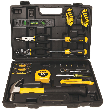Installing Auxiliary Gas Heaters
Written by Lee Wyatt (last updated February 23, 2022)
While it might be nice to go outside and enjoy the snow, or cold air of late fall and winter, no one really likes to have their home feel that way all the time. One method for combating a situation like this would be to purchase a completely new gas heater for your home. However, instead of purchasing a completely new gas heater for your home you can always try installing auxiliary gas heaters. Simply put, these are heaters that work in conjunction with your main heater, and help keep the house warm in a nice and unified manner. In fact, by having these auxiliary gas heaters installed, you can help reduce some of the overall wear and tear that you may experience on your regular heater.
Before you begin this procedure, you need to be aware of a simple fact. This method described here does not go into detail about how you attach the auxiliary heater to your main gas line. The reason for this is simple in that only a professional heating technician, plumber, or a representative of your gas company should be the ones to do that. Gas is too dangerous of a material to risk any accidents, so leave that step to the professionals.
Materials:
- New auxiliary gas heater
- Iron gas line (supplied by heating tech)
- Type-B vent (supplied by heating tech)
- Tape measure
- Level
- Stud finder
- Noncontact voltage tester
- Drill
- Drill bits
- Screwdriver
- Saber saw
Procedure:
- Measure the area. Before you can really get started on installing an auxiliary gas heater, you need to know the size of the room you will be working with. The reason for this is that a smaller room may not be able to hold enough air for a particularly large heater. Get the size of the room by multiplying the width of the room by the length and by the height. This will give you the proper size of the room, and be sure that you write your answer down in feet so you don't forget.
- Get a proper sized heater. To determine the proper sized auxiliary gas heater for your room multiply the total number of feet you got earlier by 20. This will give you the answer of BTUs that your heater will need to have. For example, if you have a room that is 10 feet x 15 feet with an 9 foot ceiling you will have a total of 1,350. Multiply the 1,350 by 20, and you will get a total of 27,000 BTUs. This means that you will need to have either a heater that puts out 20,000 BTUs an hour, or one that will put out 30,000 and create some additional venting for the room.
- Decide on a location. Choose a wall which you will have your auxiliary heater attached to. Ideally the location should be a clear space that is either under a window or near one. Most heaters will require some clear space around them, so make sure that you are familiar with what your owners manual recommends. Once you have chosen a location, mark the area with a level straight line.
- Locate the studs. Using a stud finder, go along the line that you made earlier and mark where the studs will be. These heaters are somewhat heavy, and will require all the support that the studs can offer. Mark each of the stud locations with some masking tape.
- Attach brackets. Drill some guide holes with your drill and drill bits into the location where the studs are. Once you have the guide holes in place, begin attaching the bracket to the wall. Do not over tighten the screws or you may potentially damage the brackets. After you have attached the brackets, hang the heater on the wall.
- Attach the gas line. Contact your local gas company, heating and air conditioning technician, or even a plumber to have them come out and attach the gas line. While it is more expensive to have them do the work for you, it is certainly safer. This way you will be able to be certain that the gas line is attached correctly and that there are no leaks.
Author Bio
Lee Wyatt
Contributor of numerous Tips.Net articles, Lee Wyatt is quickly becoming a regular "Jack of all trades." He is currently an independent contractor specializing in writing and editing. Contact him today for all of your writing and editing needs! Click here to contact. Learn more about Lee...
Installing a Fence
Whether you are looking to increase the safety of your home, or simply want to add a design element, installing a fence ...
Discover More
Common Human Parasites
For many people when you ask them what the most common human parasites are, they will typically say something about ...
Discover More
Removing Soy Sauce Stains
If you enjoy having oriental food, then chances are you have come across a soy sauce stain every so often. Removing soy ...
Discover More
More Home Improvement Tips
Heating Up a Cold Room
While it is tempting to do so, there are other ways of heating up a cold room besides turning up the thermostat. Try a ...
Discover More
Installing an Evaporative Cooler
One of the best ways to cool your home during the hotter months is by using an evaporative cooler. If you don't already ...
Discover More
Insulating Basements
Considering that many homes have their heating and air conditioning units in the basement, it only makes sense that these ...
Discover More

Comments